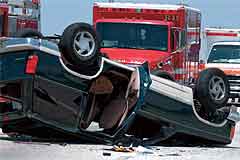A federal proposal to strengthen passenger vehicle roofs won’t produce big benefits. The National Highway Traffic Safety Administration (NHTSA), which issued the proposal, estimates that fewer than 50 lives would be saved each year. Still the new standard would represent a step in the right direction.

*THE DRIVER OF THIS SUV DIED WHEN HIS VEHICLE ROLLED OVER IN A CRASH. A PROPOSED FEDERAL STANDARD COULD HELP TO REDUCE DEATHS IN ROLLOVER CRASHES BY REQUIRING STRONGER VEHICLE ROOFS. IN THE FUTURE NHTSA ALSO NEEDS TO DEVELOP A NEW TEST TO ASSESS ROOF STRENGTH.*
There are two main aspects of NHTSA’s proposal to upgrade Federal Motor Vehicle Safety Standard 216. One would require the roofs of passenger vehicles to withstand a force of 2.5 times vehicle weight - up from 1.5 times under the current standard - without intruding too close to occupants’ heads. The other key aspect is that the new standard would apply to vehicles weighing up to 10,000 pounds, extending the requirements to bigger SUVs and pickups. The current standard only goes up to 6,000 pounds.
“The extension of the requirements to heavier vehicles is important because so many of these vehicles, which are used to drive families, are more prone than cars to rolling over. They need strong roofs to reduce the high proportion of occupant deaths that occur in rollover crashes,” says Institute president Adrian Lund.
Institute analyses of motor vehicle deaths in 2004 indicate that almost half of all SUV occupant deaths, compared with about 20 percent of car occupant deaths, occurred in single-vehicle rollovers. Strengthening vehicle roofs helps to reduce these deaths by keeping the tops of rolling vehicles from collapsing and intruding into the space around the occupants.
Ensure adequate headroom: The Institute supports NHTSA’s proposal to require occupant compartments to retain enough headroom to accommodate an average-size man. But in some cases what the agency proposes could lead to the weakening, not the strengthening, of vehicle roofs. To address this, the Institute has advised NHTSA to modify its proposed rule to guarantee that complying vehicles also would meet the old rule. Then roofs couldn’t be weakened and still comply with the new standard.
Another concern is that NHTSA is considering relaxed requirements for vehicles with low rooflines and, hence, limited headroom. The Institute advises the agency to abandon this idea. It wouldn’t make sense for NHTSA to ease the requirements for the very vehicles with the greatest need for stronger roofs - those with rooflines deroof signed the lowest and therefore closest to occupants’ heads.
Modify the test procedures too: The static test that applies force to vehicle roofs also needs to be changed. The Institute recommends specifying a range of angles, not just one, under which a roof would have to hold up under the force.
“Another important change would be to test vehicles without their windshields because it’s unclear how often windshields remain in place during rollover crashes and how much a windshield helps to reduce roof crush,” Lund explains. “Applying the test force to the tops of vehicles without their windshields would encourage automakers to design stronger roofs.”
Critics take note of the modest gains: NHTSA estimates that 13 to 44 lives would be saved each year. This benefit is modest in part because more than half of all vehicles that would be subject to the new standard already meet its requirements.
Critics say the proposal won’t accomplish much of anything. One safety advocate dubs it “virtually a nothing burger.”
Lund counters, “There’s substance to NHTSA’s current proposal, although it’s true this isn’t all the agency needs to do. The problem is that there’s not enough empirical evidence to justify more stringent roof strength requirements. We suggested some changes NHTSA could make to the static test that’s used to assess roof strength, but what’s really needed is a dynamic test.”
Need new test of vehicle roof strength: A major impediment to establishing a dynamic test is the absence of good research to guide the development of a repeatable rollover test. Another problem is that researchers aren’t yet able to estimate the benefits of designing passenger vehicles to comply with a dynamic test. Plus the test itself won’t be easy to develop.
“Rollovers are complicated. Many factors influence their outcomes,” Lund says. “It will be a challenge to develop a dynamic test that will assess the interactions of a vehicle’s structure, its restraint systems, and occupant kinematics. NHTSA needs to get going on the research needed to meet this challenge.”
In the meantime, the agency reports that its current proposal to upgrade roof crush resistance, based on static testing, could become a final rule this year. The current standard has been in effect since 1971.




